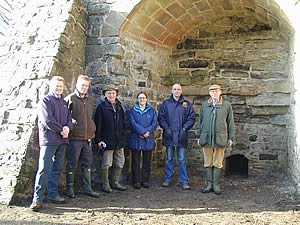Defra helps fire up
interest in historic Lime Kilns
23/02/05
 Two historic Grade II Listed lime kilns in the heart of the Northumberland
countryside have been preserved for future generations with the
help of Defra. Two historic Grade II Listed lime kilns in the heart of the Northumberland
countryside have been preserved for future generations with the
help of Defra.
The Christon Bank Lime Kilns, on the edge of the village of Christon
Bank, lie within the 2,000-acre Fallodon Estate, owned by Peter
Bridgeman.
Mr Bridgeman signed up to Defra's Countryside Stewardship Scheme
(CSS) and was awarded funding to help repair and preserve the lime
kilns, which are set on a bridleway leading from the seaside village
of Embleton and are a place of interest for visitors and tourists.
He was also awarded a conservation grant from Alnwick District
Council to assist with the project.
The Christon Bank Lime Kilns are listed as buildings of architectural
and historic interest and are described as a good example of a
double unit lime kiln.
Mr Bridgeman explained:
"The kilns are typical of buildings on the estate and were
constructed to a very high standard, but they were suffering from
deterioration, mainly due to scrub becoming overgrown on and around
them.
"Through the CSS agreement we've been able to clear away
the vegetation and bring in experts to repair and repoint the stonework
of the buildings. This will help preserve them for future generations
and provide an interesting feature for those using the bridleway."
Ray Connell, principal at Alnwick's Reavell & Cahill Architects,
which has overseen the repair work carried out by Historic Building
Services of Acomb, near Hexham, said:
"The kilns, which date back to the early 1800s, are part
of a complex that includes the limestone source, a quarry now flooded,
an approach ramp and a number of bell pits in an adjacent field,
which may have provided the poor quality coal necessary for the
burning process. Lime improves crops by counteracting soil acidity
and improving soil structure and the kilns were used to produce
the large amounts of lime that were needed in the mid-18th and
19th centuries during the 'age of agricultural improvements'."
Neil Tulloch, an an adviser for Defra's Rural Development Service
in the North East, said:
"We have more than 1,000 agreement holders across the North
East with almost 92,000 hectares of land covered by agri-environment
schemes that are helping preserve and enhance our landscape and
wildlife habitats.
"Many agreement holders, like Mr Bridgeman, have incorporated
projects to preserve and enhance important archaeological or historical
features on their land and we're delighted that we have been able
to assist in this conservation work at Christon Bank.
"The lime kilns at Christon Bank are a great example of what
is now a valuable part of agricultural history and we're delighted
to have played a part in their preservation."
Mr Bridgeman's agreement has also included a range of environmental
works including hedge planting and restoration, tree planting,
pond creation and the establishment of grass margins around arable
fields.
|


 Two historic Grade II Listed lime kilns in the heart of the Northumberland
countryside have been preserved for future generations with the
help of Defra.
Two historic Grade II Listed lime kilns in the heart of the Northumberland
countryside have been preserved for future generations with the
help of Defra.